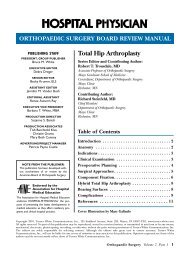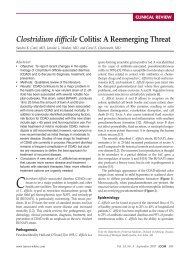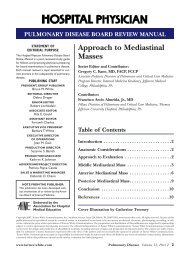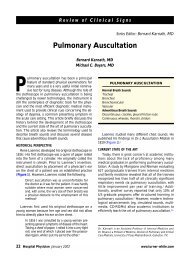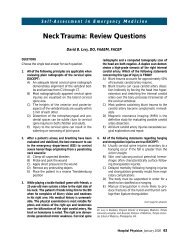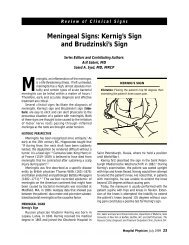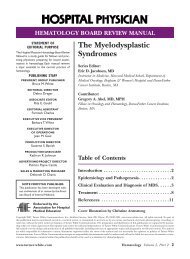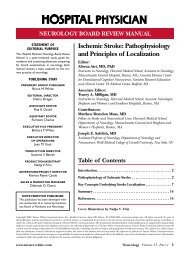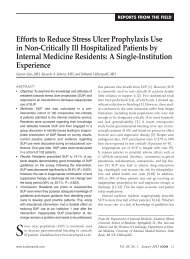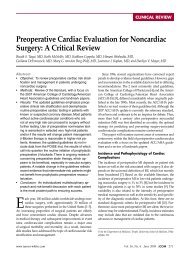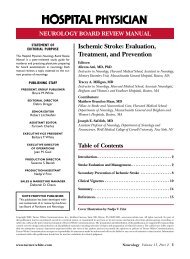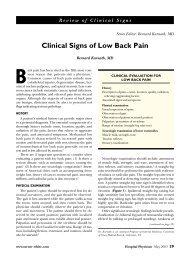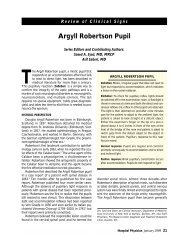Intermittent Explosive Disorder - Turner White
Intermittent Explosive Disorder - Turner White
Intermittent Explosive Disorder - Turner White
Create successful ePaper yourself
Turn your PDF publications into a flip-book with our unique Google optimized e-Paper software.
I n t e r m i t t e n t E x p l o s i v e D i s o r d e r<br />
adolescence, and risk factors include male sex, young<br />
age, being married, a decreased household income,<br />
and a high degree of social impairment. Studies evaluating<br />
IED are sparse, and studies evaluating treatments<br />
for IED are even more so. Currently, there are no drugs<br />
approved for the treatment of aggression; however, studies<br />
have demonstrated decreased aggression in certain<br />
populations with the use of pharmacologic agents, such<br />
as lithium, atypical antipsychotics, valproic acid, phenytoin,<br />
SSRIs, and β blockers, and psychotherapy.<br />
SUMMARY POINTS<br />
• Recent studies have indicated that IED is much more<br />
prevalent than previously thought; a recent study of<br />
9282 individuals found an incidence of 7.3% for lifetime<br />
diagnosis of IED and 3.9% 12-month incidence<br />
rate.<br />
• Diagnosis of IED can be difficult due to vagueness of<br />
the diagnostic criteria and the frequency of impulsive<br />
aggression seen in other illnesses.<br />
• When diagnosing IED, it is important to remember<br />
that the episodes of rage are short and substantially<br />
out of proportion to the stressor causing the event,<br />
and the episodes result in property damage or assault<br />
of individuals.<br />
• IED is a diagnosis of exclusion; thus, all other causes<br />
of rage and outbursts must be excluded before giving<br />
this diagnosis. Other diagnoses that can mimic<br />
IED include neurologic disorders, antisocial personality<br />
disorder, borderline personality disorder,<br />
conduct disorder, dementia with behavioral disturbance,<br />
oppositional defiant disorder, and PTSD.<br />
• Aggression of different forms is very common when<br />
patients are withdrawing or under the influence of<br />
different substances. These individuals should not<br />
be diagnosed with IED.<br />
• Patients with IED are at risk for high impairment in<br />
multiple aspects of their life. Many report difficulties<br />
psychosocially, and individuals with IED often have<br />
difficulties with significant relationships throughout<br />
their life.<br />
• The intensity of IED tends to lessen as the patient<br />
becomes older.<br />
• IED-related behavior is not the same as well-planned<br />
criminal behavior. If the behavior is premeditated,<br />
individuals should not be given a diagnosis of IED.<br />
• Although the average age of onset of IED appears<br />
to be in adolescence, most patients do not seek<br />
treatment until they are much older. The reason for<br />
seeking treatment is most often another psychiatric<br />
condition they have comorbidly.<br />
• Most patients with IED have at least 1 other lifetime<br />
DSM-IV diagnosis. It is common for individuals with<br />
this disorder to met criteria for 3 or more diagnoses.<br />
Mood and anxiety disorders are often seen comorbidly<br />
in patients with IED.<br />
• Risk factors for IED include male sex, young age,<br />
low level of education, marriage, employment, and<br />
having decreased revenue in the home.<br />
• IED is thought to arise as a result of experiences<br />
from youth and differences in brain chemistry. Early<br />
disruption of attachment to a primary caregiver or<br />
aggressive parenting has been shown to be risk factors<br />
for aggressive behaviors as adults. A decreased<br />
level of serotonin activity in the CSF has been seen<br />
in aggressive individuals.<br />
• Studies have indicated that certain areas of the<br />
brain, including the prefrontal cortex and amygdala,<br />
are involved in aggression. Individuals with<br />
lesions in the frontal or temporal lobe have been<br />
shown to have increased aggression.<br />
• According to McElroy, violent individuals with unipolar<br />
depression should be started on a serotonin reuptake<br />
inhibitor, another antidepressant, or lamotrigine.<br />
Individuals with bipolar depression and a history of<br />
mania should be treated with a mood stabilizer, antipsychotics,<br />
other antiepileptics, or antiandrogens.<br />
• If no affective component is present, patients should<br />
be evaluated for compulsive verses impulsive primary<br />
symptomatology. If the patient has compulsive<br />
symptoms, SSRIs or other sertonin agents are<br />
indicated. If the patient has impulsivity symptoms,<br />
SSRIs, other antidepressants, mood stabilizers, antiepileptics,<br />
β blockers, stimulants, or antiandrogens<br />
are indicated.<br />
• In certain populations, studies have indicated that<br />
pharmacologic treatments, such as lithium, valproic<br />
acid, carbamazepine, phenytoin, fluoxetine, or atypical<br />
antipsychotics, are more effective than placebo<br />
in treating aggression.<br />
• Nonpharmacologic therapy, such as cognitive behavioral<br />
therapy, can help decrease anger episodes<br />
in patients with anger problems. A small study<br />
indicated that insight-oriented and supportive psychotherapy<br />
was helpful in controlling aggression in<br />
some patients when exhibiting signs of IED.<br />
Hospital Physician Board Review Manual<br />
www.turner-white.com




